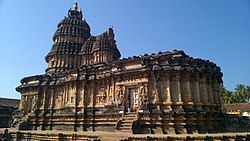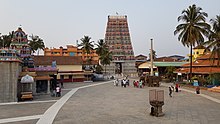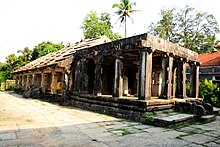Sringeri
Sringeri | |
|---|---|
Town | |
 Sri Vidyashankara temple (1342 CE) at Sringeri | |
| Coordinates:13°25′N75°15′E/ 13.42°N 75.25°E | |
| Country | |
| State | Karnataka |
| District | Chikkamagaluru |
| Region | Malenadu |
| Government | |
| • Body | Town Panchayat |
| • Chief Officer | R. Sreepad[1] |
| • MLA | T D Rajegowda (Indian National Congress) |
| Area | |
| • Town | 1.8 km2(0.7 sq mi) |
| • Rural | 442.38 km2(170.80 sq mi) |
| Elevation | 672 m (2,205 ft) |
| Population (2011)[2] | |
| • Town | 3,922 |
| • Density | 2,200/km2(5,600/sq mi) |
| •Rural | 32,617 |
| Languages | |
| • Official | Kannada |
| Time zone | UTC+5:30(IST) |
| PIN | 577139 |
| Telephone code | 08265 |
| Vehicle registration | KA-18 |
| Website | www |
Sringeri(IAST: Śṛṅgerī;Kannada:[ʃriŋɡeːri]) also calledShringeriis a hill town andTalukheadquarters located inChikkamagaluru districtin theIndianstate ofKarnataka.It is the site of the firstmaṭha(Dakshinamnaya Sringeri Sharada Peetham) established byAdi Shankara,Hindutheologian and exponent of theAdvaita Vedantaphilosophy. Located on the banks of the riverTungā,the town draws a large number of pilgrims to its temples of SriSharadamba,Sri Vidyashankara, Sri Malahanikareshvara and other deities.
Etymology
[edit]The name Sringeri is derived from Rishyashringa-giri, a nearby hill that is believed to have contained the hermitage ofRishiVibhandaka and his sonRishyashringa.In an episode in the Bala-Kanda of theRamayana,Vasishthanarrates how Rishyashringa brought rains to the drought-stricken kingdom of Romapada.[3]
According to legend, SriAdi Shankarais said to have selected the site as the place to stay and teach his disciples, because when he was walking by the Tunga river, he saw a cobra with a raised hood, providing shelter from the hot sun, to a frog undergoing labour. Astonished by the place where natural enemies had gone beyond their instincts, he stayed here for twelve years. Sri Adi Shankaracharya also established mathas in the northern (atJyotirmath,nearBadrinath), eastern (atPuri) and western (atDwaraka) quarters of India.
Geography and climate
[edit]Sringeri is located at13°25′N75°15′E/ 13.42°N 75.25°E.[4]It has an average elevation of 672 meters (2204 feet). The average annual temperature is 23.5 °C, with the highest temperatures reaching 32 °C in April and lowest temperatures of 16 °C in winter months (December–January). There is significant rainfall (annual average of 3949 mm ), mostly during the months of June, July and August.
In 2018, Sringeri received an annual rainfall of 4,981 millimetres (196.1 in), whileKiggahobli received 6,968 millimetres (274.3 in), one of the highest in the state that year.[5]During 2019 and 2022, Sringeri received 3,819 millimetres (150.4 in)[6]and 3,892 millimetres (153.2 in) of annual rainfall, respectively.[7]
Demographics
[edit]As of the 2011 Indiacensus,Sringeri had a population of 36,539. Males constitute 49% of the population and females 51%. Sringeri has an averageliteracy rateof 86%, higher than the national average of 74%: male literacy is 90%, and female literacy is 82%. In Sringeri, 8.5% of the population is under 6 years of age.[2][8]
Temples in Sringeri
[edit]Sringeri is home to a number of historic temples. Of these,Sri Sharadamba temple,Sri Vidyashankara templeand Sri Malahanikareshwara temple are the most prominent.
Sri Sharadamba temple
[edit]The ancient temple of SriSharada,the presiding deity of Sringeri has a glorious history that begins with the setting up of theDakshinamnaya Sringeri Sharada Peethamby SriAdi Shankara.Originally it was an unpretentious shrine with the idol of Sharada made of sandalwood, installed over theSri Chakrathat SriAdi Shankaracarved on a rock. Subsequently, Sri Bharati Krishna Tirtha andSri Vidyaranyahad a temple built in the Kerala style, with timber and tiled roof, and substituted the sandalwood idol with the present golden idol.
Sri Sacchidananda Shivabhinava Nrisimha Bharatiraised the present structure in granite around the sanctum and SriChandrasekhara Bharaticonsecrated the new temple in May 1916.Sri Abhinava Vidyatirthamade several improvements in the temple. Themahamandapamhas large stone pillars exquisitely carved with deities like Durga, Raja Rajeshwari, dwarapalakas and devis which are all sculpted according to theshilpa sastraspractised inTamilnadu.

Construction of the 127 feet tallRajagopuramentrance was completed in 2014 and itsKumbhabhishekam(grand inauguration) was performed by Sri Bharati Tirtha Mahaswamiji on 8 June 2014, the day of Jaya Samvatsariya Jyeshtha Shuddha Dashami.
In addition to Sri Sharadamba temple, the following temples and shrines are within the temple complex:
- Sri Thorana Ganapathy
- Sri Adi Shankaracharya
- Sri Shakthi Ganapathy
- Sri Kodandaramaswamy
- Sri Malayala Brahma
- Sri Sureshwaracharya
- Sri Vageeswari Vidyaranya
- Sri Janardhanaswamy
- Sri Anjaneya
- Sri Garuda
- Sri Balasubrahmanyaswamy
Sri Vidyashankara temple
[edit]
The Vidyashankara temple was built in the year 1338 A.D., in commemoration of the pontiff Sri Vidyashankara, by Sri Vidyaranya, patron-saint ofHariharaandBukka,the brothers who founded theVijayanagara empire.Inscriptions in the temple record contributions made by several Vijayanagara emperors but the temple was probably built on an earlierHoysalasite as it combinesHoysala(Chalukya) andVijayanagara(Dravida) architectural features. It is built entirely of stone and stands on a high plinth, more or less a rectangle with apsidal east-west ends. On the western side is the garbhagriha, with VidyaGanapation one side and Durga on the other side. On the other three sides of the garbhagriha are shrines toBrahma,VishnuandMaheshwarawith their consorts.

In the eastern half of the structure is a mantapa with twelve pillars (popularly known as rashi stambhas), marked by the twelve signs of the zodiac. The rays of the sun fall on each of them in the order of the twelve solar months. On the floor is a large circle, marked with converging lines to indicate the direction of the shadows. The central ceiling is an exquisite piece of workmanship with lotus and pecking parrots. The vimana over the garbhagriha rises with shikhara, mahapadma and stupa. The rest of the roof is made up of sloping channelled slab. The basement is elaborately sculpted with animals, puranic stories,Shiva,Vishnu,Dashavatara,Kali,Shanmukhaand so on. Other intricate features include chains of stone rings and growling lions with stone balls inside the faces, which can be rotated. The temple is under the care of theArchaeological Survey of India.[9][10][11][12]
Vidyatirtha Rathotsava is celebrated on a grand scale during kartika shukla paksha. The festival spans for seven days from tritiya to navami. On the saptami day Jagadguru Bharathi Teertha Mahaswamiji[13]performs special puja. The aradhana of Sri Vidya Shankara is performed on shasti, saptami and ashtami.
Sri Malahanikareshvara temple
[edit]
Malahanikaresvara means destroyer of the impurities of the soul. This serene temple is located at the centre of the Sringeri town, atop a small hill, and can be reached by a flight of about 170 steps. The temple structure is a fine piece of architecture in stone, consisting of navaranga, antarala and garbhagrha. The ceiling has a lotus bud carving. The deities inside the temple include Malahanikaresvara, Bhavani, Chandikeshwara, Durga and Sthambha Ganapati. The linga is said have been worshiped by Sage Vibhandaka, son of Sage Kashyapa. After many years of penance, Vibhandaka had the vision of the Lord and merged into the Linga. The Sthanbha Ganapati was created in stone by Sri Ahinava Narasimha Bharati (1599 – 1622), the 24th Jagadguru, by drawing a figure of Ganesha with a piece of turmeric on one of the front pillars. Outside the temple, there are small shrines of Meenakshi Sachidanandeshvara, Kshetra Palaka and Bindu Madhava.
On Mahashivaratri, the Jagadguru performs special Puja to the Lord. On Kartika Poornima day, Laksha Deepothsavam is celebrated on a grand scale in the presence of the Jagadguru.
Temples of guardian deities
[edit]SriAdi Shankaraalso established guardian deities around Sringeri in four directions.
- Kala Bhairava Templein the East
- Kere Anjaneya Templein the West
- Kalikamba Templein the North
- Durgamba Templein the South
Sri Parshwanath Swamy Basadi
[edit]
Sri Parshwanath Basadi (Digambar Jain Temple) is situated in the heart of Sringeri Town. This basadi was built in the memory of Mari Setty whose origin goes to one Vijayanagara Shanthi Shetty of Nidugodu village nearBelur.The date of construction comes to about 1150 CE. The main temple is 50 feet long and 30 feet wide. Completely built of stone it has a sloped roof. The Basadi consists ofGarbhagriha,Sukhanasi, Navaranga, MukhaMandapaandPradakshinaPatha.[14]
In the Garbhagriha, there is the idol of SriParshwanathaSwamy, the presiding deity made of black stone. It is one foot high and on its base, the words Srimathparisanathaya Namaha are inscribed. Generally a single cobra holds its hood over the Lord’s head. But here, the speciality is that a pair of cobras intertwined hold their seven hoods like an umbrella. Hence this deity is known as Jodi Parshwanatha Swamy.[14]
In the sukhanasi the idol of GoddessPadmavatiis kept. It is about nine inches in height and is made of black stone. Besides this there are also Jina images of marble, sphatika, black stone and the bronze images of 24tirthankarasin the Gandhakuti, as well as idols ofBrahma,Saraswathi,andGanadharas.[14]
Sringeri Sharada Peetha
[edit]
The Sringeri Sharada Peetha or Matha is located South of the Sri Sharadamba temple, across the Tunga river, in Narasimha Vana. A foot bridge, called Vidyatheertha Setu connects the two sides. TheSringeri Sharada Peetha,also calledDakshinamnaya Sringeri Sharada peetam,is one of the fourHinduAdvaitamaths established by SriAdi Shankara.Following the tradition initiated by Adi Shankara, the maţha is in charge of theYajur Veda(the Krishna (Black) Yajurveda is more prevalent in South India, over which the maţha has authority in the Smarta tradition). The head of the matha is calledJagadguru(teacher to the world) and also carries theShankaracharyaname as a title. The presentSringeri ShankaracharyaShriBharati TirthaSwamiji has nominated Jagadguru Vidhushekhara Bharathi as his successor.
Nearby places of interest
[edit]There are several other historic temples and places of interest around Sringeri.
Sri Chaturmurti Vidyeshwara temple, Simhagiri
[edit]Simhagiri (old Sringeri) is a small village about 2 km from Sringeri bus stand and comes on the way toVidyaranyapura.It was established by the Sri Simhagiri Mahaswami, the 7th Jagadguru who had adorned the Sringeri Peetham in the 11th century. Sri Chaturmurti Vidyeshwara temple contains a statue combining four idols, that of Sri Vidyatirtha, Bhahma, Vishnu and Shiva. The village houses several priests of the temples in Sringeri.
Rajiv Gandhi Kendriya Sanskrit Vidyapeetha, Menase
[edit]Menase is around 4 km from Sringeri bus stand, on the road toBalehonnur.Rajiv Gandhi Kendriya Sanskrit Vidyapeethawas established in 1992, as one of the campus ofCentral Sanskrit University,New Delhi. Its foundation stone was laid by Sri Bharati Teertha Mahaswamiji in the presence of ShriR. Venkataraman,the then President of India. The 10 acre campus includes hostels for boys and girls.
Sri Rishyashringeshwara temple, Kigga
[edit]Kiggais a small village located 9 km from Sringeri. Sri Rishyashrungeshwara temple is located on the banks of Nandini river, a tributary of Tunga. Built duringVijayanagaraperiod, the temple houses a linga of a unique shape, with three protuberances resembling horns. There is a big Nandi statue in front of the temple. Sage Rishyasringa is said to have performed penance here. It is believed that the worship of the linga averts famine in the land up to a distance of 12 yojanas (100 miles). The rathotsavam of the temple is conducted in the month of Chaitra (March/April).
Sirimane falls, near Kigga
[edit]Sirimane fallsis situated at a distance of 12 km from Sringeri, and 5 km from Kigga. Visitors can take a bus from Sringeri to Kigga, then hire a local autorikshaw (3-wheeler) to reach the falls.
Sri Sharada Lakshminarasimha Peetam, Hariharapura
[edit]Hariharipurais about 20 km from Sringeri. Here, Sri Sharada Lakshminarasimha Peetam was established by Sri Adi Shankaracharya on the banks of the River Tunga. The place is serene amidst forest, Arecanut farms and rice fields surrounded by small hills. There is a 110 year old bridge across the Tunga connecting Hariharipura to Koppa. This bridge is believed to have been built bySir M Visvesvaraya.
See also
[edit]- Agumbe
- BelurandHalebidu
- Dharmasthala
- Hanumanagundi falls
- Karkala
- Kundadri hills
- Horanadu
- Mangalore
- Chikmagalur
- Subramanya
References
[edit]- ^"TP Shringeri".Retrieved30 August2023.
- ^ab"Census of India 2011 - District Census Handbook - Chikmagalur - Karnatakaook"(PDF).Office Of The Registrar General & Census Commissioner India.p. 22.Retrieved30 August2023.
- ^"The legend of Rishyasringa".Sringeri Sharada Peeta.Retrieved7 November2006.
- ^"Maps, Weather, and Airports for Sringeri, India".fallingrain.
- ^"Annual State Report 2018"(PDF).Retrieved14 August2023.
- ^"Annual State Report 2019"(PDF).Retrieved14 August2023.
- ^"Annual State Report 2022"(PDF).Retrieved21 June2023.
- ^"Census of India 2001: Data from the 2001 Census, including cities, villages and towns (Provisional)".Census Commission of India. Archived fromthe originalon 16 June 2004.Retrieved1 November2008.
- ^http:// sringeri.net/temples/sri-vidyashankara%7Caccessdate=15 March 2015|
- ^"Sri Vidyashankara Temple".Sringeri Sharada Peeta.Retrieved7 November2006.
- ^"Zodiacal pillars of Sringeri"(PDF).Current Science.Indian Academy of Sciences. Archived fromthe original(PDF)on 7 October 2007.Retrieved25 March2006.
- ^"Vidyashankara Temple".Indiantemples.Retrieved7 November2006.
- ^"Sri Bharati Tirtha Mahaswamiji".
- ^abcKrishna, M. H.(1931).Annual Report of the Mysore Archaeology Department(PDF).Bangalore: Superintendent at the Government Press. p. 15.
External links
[edit] Sringeritravel guide from Wikivoyage
Sringeritravel guide from Wikivoyage- A Photo Essay of Sringeri
- Someoffbeat photosof Sringeri
- Shankara Sringeri
- Sri Parshwanath Swamy Digambar Jain Temple

